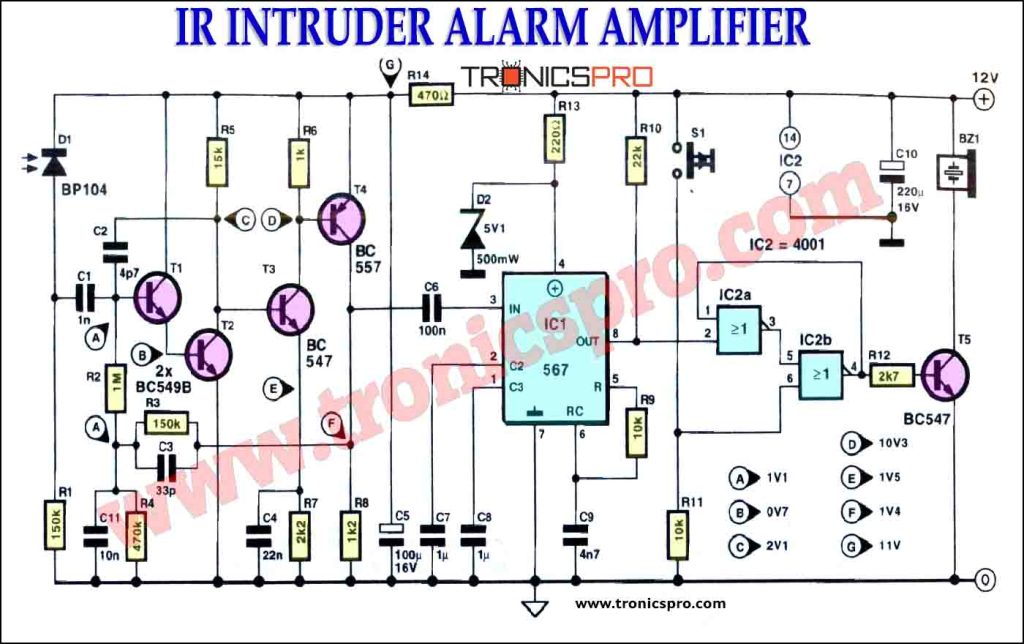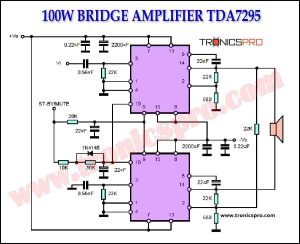Introduction
Intruder alarm circuits are electronic systems designed to detect unauthorized entry or access to a property or area and alert the residents or authorities of the threat. One of the widely used types of intruder alarm circuits is the IR (Infrared) intruder alarm circuit, which uses infrared light technology to detect motion and movement. These circuits are widely used in homes, offices, and other commercial properties, adding an extra layer of security and peace of mind to residents and owners.
The alarm circuit uses infra-red light beams to bridge distances between 3 m and 5 m (10 ft to 16 ft), but if the transmit diode is given a reflector, larger distances are possible. When the beam is interrupted, a buzzer sounds.
The transmitter is based on IC1, which generates 10 us wide pulses at a rate of 20 kHz. During the pulse, a current of about 100 mA flows through the transmit diode. The average current drawn by the transmitter is about 12 mA, which will normally preclude a battery-operated supply.
Circuit Diagram
of IR Intruder Alarm Circuit
This amplifier can be designed using a few basic components. The circuit diagram of this project is shown below.
More Circuit Layouts








Working Explanation
of IR Intruder Alarm Circuit
The receive diode is normally cut off, but comes on when it is exposed to infra-red light. The more intense the infra-red light, the larger the photo current. The received pulses cause an alternating voltage across resistor R1.
The a.c. coupled amplifier based on transistors T1-T4 provides an amplification of x200 at a frequency of 20 kHz.
The bandwidth of the receiver is purposely limited to enhance the stability of the circuit.
The pulses arriving from the transmitter are intercepted by tone decoder IC1. Provided the pulse rate is correct, the output of the decoder is logic low. This holds bistable IC3 in the reset state, so that the buzzer remains inactive.
When the infra-red signal fails (because the beam is broken), the bistable is set, whereupon the buzzer is actuated. The sounding of the buzzer cannot be interrupted with switch S1. When, however, the beam is restored, pressing S1 causes the bistable to be reset, whereupon the buzzer is switched off.
The receiver draws a current of about 30 mA in the quiescent state, which rises to about 50 mA when the buzzer sounds.
The relatively large currents make battery operation uneconomical; it is far better (and safer) to use an appropriate mains adaptor.
Conclusion of IR Intruder Alarm Circuit
The IR intruder alarm circuit is a highly effective and reliable device for securing and protecting properties against intruders. With its infrared-based motion detection technology, it can detect even the slightest movement and trigger an alarm, notifying the residents of any potential threats to their property. It is highly recommended for anyone looking to enhance their security measures and deter burglars and intruders from accessing their properties.
More projects, You may like:
- Video Transmitter DIY Homemade FM Radio Transmitter
- Adjustable Power Supply DIY Battery Charger
- 12V-220V 500 Watt inverter DIY Homemade
- 12V-220V H-Bridge Inverter DIY Homemade
- MPPT Solar Charge Controller DIY Homemade
- 18650 battery bank free charge protection module
- D718 B688 Bass Amplifier Homemade DIY
- C5200 Bass Amplifier DIY Homemade with Volume
- DIY LA4440 bass amplifier homemade
- C5200 A1943 TDA2030 Amplifier DIY Homemade




























